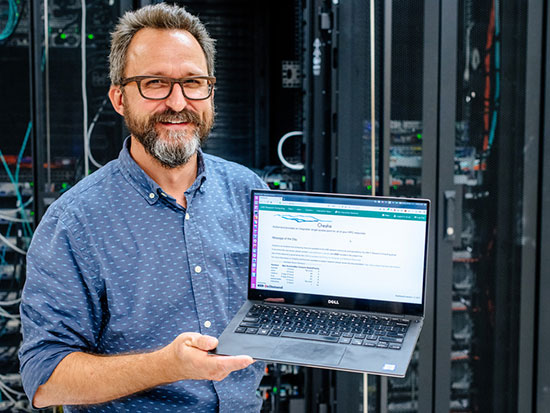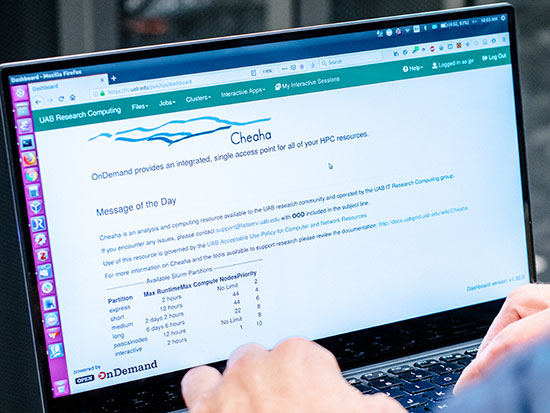 John-Paul Robinson, high-performance computing architect, displays On Demand in front of the Cheaha supercomputer.Here is the old way for new users to access Cheaha, UAB’s supercomputer:
John-Paul Robinson, high-performance computing architect, displays On Demand in front of the Cheaha supercomputer.Here is the old way for new users to access Cheaha, UAB’s supercomputer:
- Sign up for a Cheaha account.
- Open a Terminal window.
- Type in a list of commands.
- Send an email to Research Computing about the errors you get.
The traditional method of logging on to the Cheaha cluster, the fastest in Alabama, was “like something out of ‘Tron’ or ‘War Games,’” said William Monroe, the UAB IT Research Computing scientist who often was on the other end of those emails.
Today there is UAB Research Computing On Demand, a web portal — at rc.uab.edu — that brings Cheaha supercomputer access as close as the nearest web browser. “This helps people who are not ‘command-line commandos,’ who are used to a windowed interface,” said Ralph Zottola, Ph.D., assistant vice president for research computing. (Learn more about Zottola and his plans for UAB Research Computing in this related story.) “It’s opening access to a lot of new users. And we’ve already seen a benefit in reduced calls for support.”
In addition to Cheaha access, the portal “includes all the popular applications that people are using here, including MATLAB, RStudio, SaS and Jupyter Notebooks,” Zottola added. “You start them up on your browser, but they’re not running on your computer. They’re running on the supercomputer.”
No experience necessary
“We have a sizable community of folks who are interested in high-performance computing or computational research but don’t have a lot of long-term experience using clusters,” said John-Paul Robinson, high-performance computing architect for UAB IT Research Computing.
 |
| “It makes collaborations that would be difficult otherwise easier. A process that takes 30 minutes or an hour on the computer in your office can take seconds using the cluster, so why not do it the easy way?” |
With On Demand, “you’re not learning how to work with this unfamiliar tool,” Robinson said. “You’re just using your browser like you do everywhere else on the web. We’ve removed a lot of potential apprehension and learning overhead in approaching the cluster. A new user can spend an hour in a tutorial and be functional in using the cluster; that process used to take much longer, sometimes weeks of learning the ins and outs.”
Before April, when the On Demand system launched, “most of our tickets were along the lines of ‘How do I submit a job?’ or ‘SSH is not working,’” Robinson said. “Now we’re still engaging with users, but it’s on higher-level problems. Not ‘Why is my login not working?’ but ‘Why is my machine-learning model not working?’”
More coming soon
New features are being added over time, with contributions from Research Computing’s new internship program, which began this year. One major upgrade, coming soon, is automated user registration — replacing a manual process that currently involves multiple emails and a developer creating each user account.
“That’s the kind of self-service we’re looking to provide to the research community on campus,” Robinson said. “It makes collaborations that would be difficult otherwise easier. A process that takes 30 minutes or an hour on the computer in your office can take seconds using the cluster, so why not do it the easy way?”
Related story:More storage, better data, new partners: Zottola’s people-first approach to research computing |
